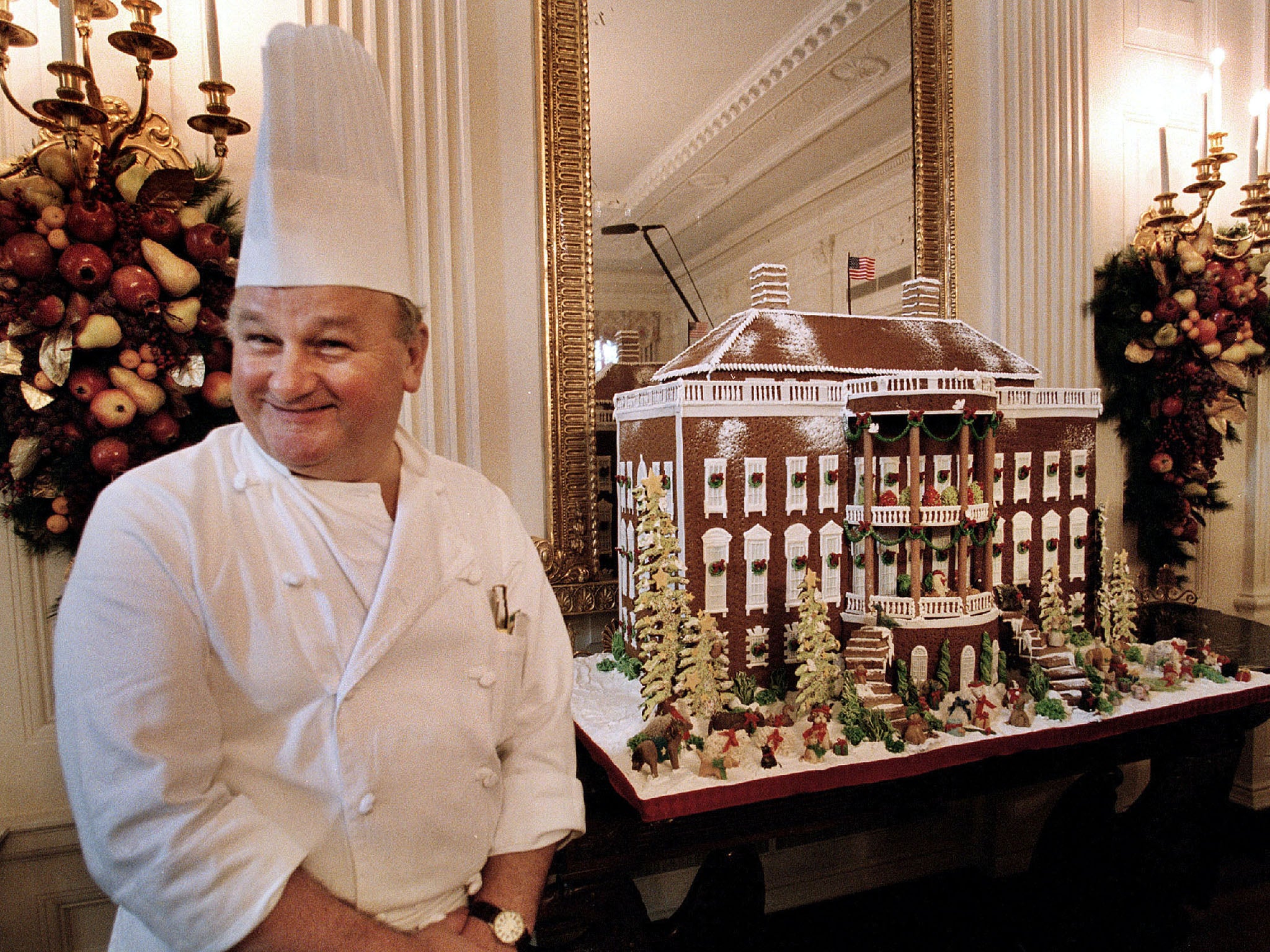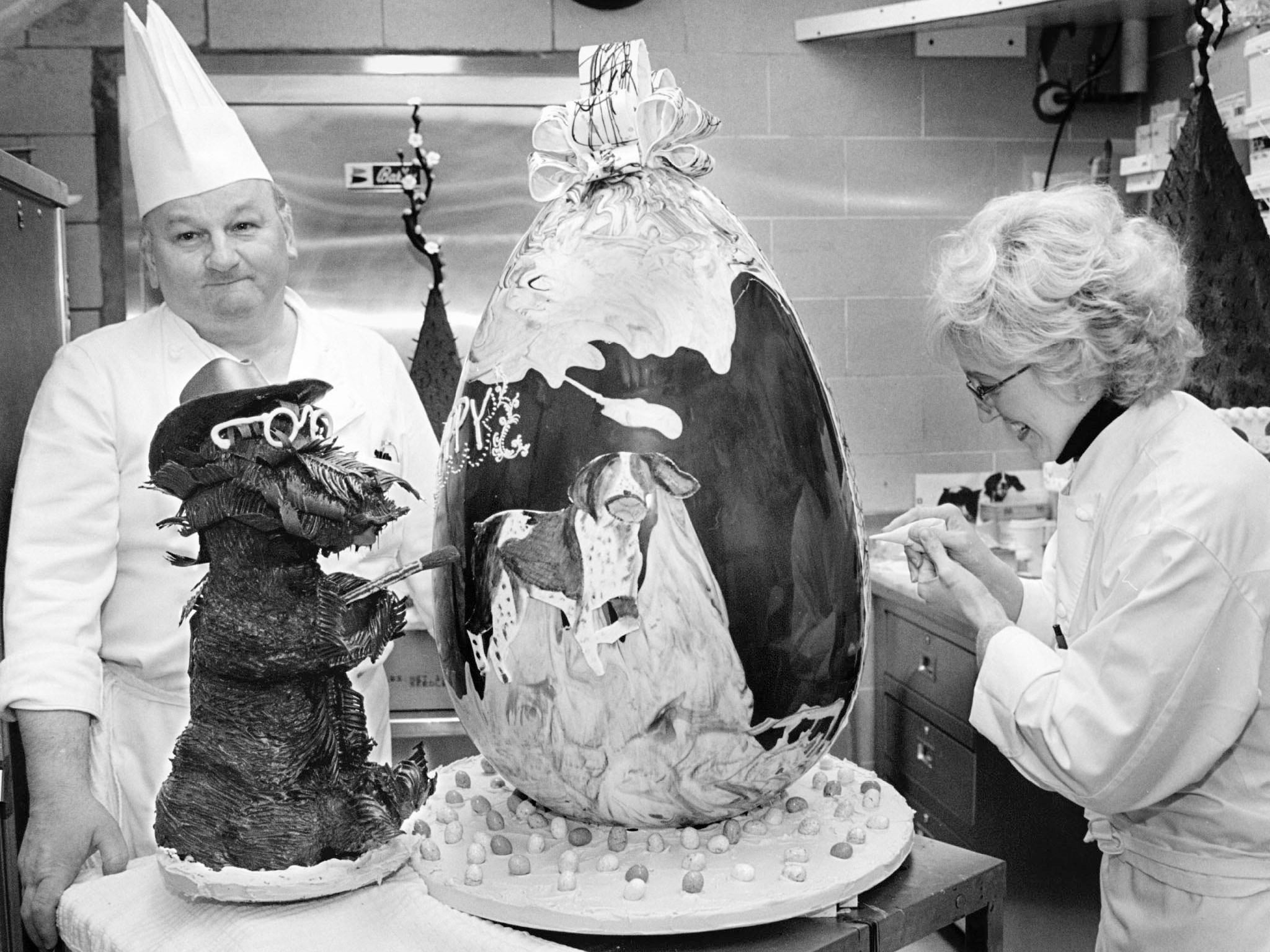Roland Mesnier: White House pastry chef for a sweet quarter-century
A confident and methodical patissier, Mesnier was a master at creating decadent, sugary showstoppers

Roland Mesnier, the French-born pastry chef who whipped up desserts for five presidents and dignitaries over a quarter of a century in the White House and boasted of never serving the same dish twice, has died aged 78.
Mesnier, whose career started with a $1 (87p) per month pastry apprenticeship at 14, was offered the White House job in 1979 after pleasing first lady Rosalynn Carter with his promise that he would focus on lighter dessert fare such as fruit. Indeed, he had a knack for modifying decadent confections with low-calorie ingredient substitutes and, when a luxurious mood prevailed, he proved a master at creating the blown and pulled sugar sculptures that adorned his desserts. He showed a whimsical side by making extravagant gingerbread houses for the Christmas season, part of a White House tradition.
His mission, he said, was to comfort a family living under constant scrutiny, and to understand its culinary tastes and pleasures. “If I could take away that pressure for five minutes, then I did my job,” he once told The Canadian Press. “That was my role in the White House – to put a smile on the face of the first family.”
A confident and methodical patissier who took as his motto “Perfection is no accident”, he tasted every dessert that left his kitchen, carefully inspected finished plates to see what was left untouched, made allies with the White House butler to glean more insights into presidential tastes, and started planning for Christmas in June.
In interviews and books, he revealed insights into the palate and temperament of presidents and first ladies for whom he worked.
The Carters insisted on adding to the White House menu a moulded cheese ring – “a mixture of muenster, cheddar, all the stickiest cheese you could find, mixed with onions, capers and strawberry jam in the middle ... It was a secret family recipe that no one tried to steal.”
The Clintons, however, did not deserve any Michelin stars for their family recipe: “An atrocious concoction of Coca-Cola-flavoured jelly served with black glacé cherries.” The Carters, perhaps surprisingly because of their background farming legumes in their home state of Georgia, “did not care for peanuts at all”.
Mesnier would satisfy Ronald Reagan’s chocolate cravings, routinely denied by the first lady, by preparing a chocolate mousse when the first lady was out of town. Of Nancy Reagan’s tastes, he learned that “if she didn’t complain, that was a compliment”.
On one occasion, Nancy Reagan rejected three different desserts Mesnier presented to her for a state dinner to be attended by the queen of the Netherlands. On the Sunday before the Tuesday-night dinner, she called him back to the White House and gave highly specific instructions: to make 14 sugar baskets that are eight inches in diameter, and decorate each handle with six tulips made of sugar, before filling the baskets with sorbet and fresh fruit.

“She tilted her head and said, ‘Roland, you have two days and two nights,’ and I said, ‘Thank you, Madam,’” Mesnier recounted to The New York Times. “It was another test, and you know it makes you strong. Mrs Reagan pushed me to be who I became.”
Serving politicians and other dignitaries who looked after their appearance, he made healthy modifications to heavy desserts. His apple cider brûlée featured apple cider and cornstarch instead of cream. His soufflés and mousses avoided egg yolks. But like those who employed him, he did not stint on flair: he was known for his moulded chocolate, made with his own moulds, and his sugar work was nonpareil.
Francois Dionot, the founder of the now-closed L’Academie de Cuisine, one of the US’s top cooking schools, described Mesnier to the Los Angeles Daily News as “king of sugar work – spun sugar, poured sugar, rock sugar, pulled sugar. Very few people know how to do this any more. He makes roses that look real.”
Mesnier boasted of never having made a bad dessert at the White House – an achievement he attributed to gruelling hours and years training at his craft before setting foot in 1600 Pennsylvania Avenue. He advised aspiring pastry chefs to relax before they start the cooking process.
“Most people run afoul of baking because they are too uptight when they bake,” he told The Baltimore Sun in 2007. “I used to have a glass of wine before I baked. It worked for me. And if all else fails, just finish the bottle of wine.”

Roland Robert Mesnier (pronounced MES-knee-ay) was born in Bonnay, in rural eastern France, on 8 July 1944, the seventh of nine siblings. His father worked for the railway network, and his mother was a homemaker – and, by his account, “a wonderful chef”.
He became interested in a culinary career through his older brother Jean, one of the primary bakers in a pastry shop. At 14, Mesnier began a three-year pastry apprenticeship in Besançon, earning the equivalent of $1 a month. The first year was spent scrubbing floors and washing pots, before the chef showed him how to make a croissant. “You never forget when you make your first croissant,” he recalled to The Charlotte Observer.
After his apprenticeship, he worked in pastry shops and hotels in Paris, in Hanover and Hamburg in Germany, and in London at the Savoy Hotel, which he identified to the White House Historical Association as “the launchpad to my ambitions and dreams”.
In 1967, Mesnier became head pastry chef at the Princess Hotel in Bermuda, where he met Martha Whiteford, an American schoolteacher from West Virginia. The two married in 1969 and had one son, George, in 1971. Martha died in January this year. In addition to his son, survivors include two sisters and a brother.
In 1976, Mesnier left Bermuda for the Homestead resort in Hot Springs, Virginia, where he worked until he joined the Carter White House kitchen.
After he left the White House during the George W Bush administration in 2004, he wrote a recipe book and memoir, All the President’s Pastries (2007, with co-author Christian Malard).
Only once, he recalled to The Washington Post, did he bend the firm rules of White House employment. It was in 1987, and Soviet leader Mikhail Gorbachev visited President Reagan in Washington. Although it is standard that all food gifts sent to the White House are destroyed for security reasons, he could not bring himself to part with two enormous tins of Russian caviar that had come from Gorbachev.
“I looked at the other chef and said, ‘I don’t know about you, buddy, but I’m willing to die for what’s inside,’” he remembered. “‘So I’m taking one home, and you can have the other one.’”
Roland Mesnier, pastry chef, born 8 July 1944, died 26 August 2022
© The Washington Post


Bookmark popover
Removed from bookmarks